MARKET OVERVIEW
The Europe Coated Antibacterial Glass market is emerging as a critical segment within the glass manufacturing industry, driven by increasing awareness of hygiene and the need for advanced antimicrobial solutions. This market is characterized by the production and distribution of glass that has been treated with antibacterial coatings, which inhibit the growth of harmful microorganisms. This advanced glass finds applications across various sectors, including healthcare, food and beverage, and residential and commercial buildings, reflecting its versatility and growing demand.
Antibacterial glass in Europe is gaining traction due to the region's stringent health regulations and the public’s heightened focus on cleanliness. The market's primary driver is the increasing implementation of strict hygiene standards in hospitals and clinics, where the prevention of infections is paramount. The healthcare sector's reliance on sterile environments necessitates the use of materials that can continuously eliminate bacteria, thus reducing the risk of hospital-acquired infections. Coated antibacterial glass is an ideal solution in this context, offering both functionality and safety.
Moreover, the food and beverage industry in Europe is adopting coated antibacterial glass to ensure high levels of sanitation in production and packaging processes. The glass’s ability to maintain its antibacterial properties over time makes it an essential material for surfaces that come into contact with food products. This adoption aligns with the industry's goals to meet food safety standards and enhance consumer confidence in product hygiene.
In residential and commercial buildings, the application of coated antibacterial glass is becoming increasingly common. Homeowners and businesses are recognizing the benefits of incorporating materials that contribute to a healthier living and working environment. For instance, the use of antibacterial glass in kitchens, bathrooms, and high-traffic areas can significantly reduce the spread of germs. In office buildings, such glass can be used in conference rooms, common areas, and even in the construction of furniture, reflecting its broad utility.
Technological advancements play a significant role in the evolution of the Europe Coated Antibacterial Glass market. Innovations in coating technologies are leading to more efficient and durable antibacterial properties. Research and development efforts are focused on enhancing the efficacy of antibacterial coatings without compromising the glass’s aesthetic and functional qualities. These advancements are expected to broaden the scope of applications and improve the performance of antibacterial glass, making it more accessible to various industries.
The competitive landscape of the Europe Coated Antibacterial Glass market is marked by the presence of several key players who are investing in research and development to introduce innovative products. Companies are also forming strategic partnerships to expand their market reach and improve their product offerings. This competitive environment fosters continuous improvement and drives the market forward.
Looking ahead, the Europe Coated Antibacterial Glass market will continue to grow as awareness of hygiene and infection control increases. The ongoing demand from the healthcare and food industries, combined with the rising adoption in residential and commercial buildings, will sustain the market’s expansion. Additionally, technological advancements will further enhance the effectiveness and application range of antibacterial glass, ensuring its place as a vital material in maintaining public health and safety.
The Europe Coated Antibacterial Glass market is estimated to reach $191.2 Million by 2031; growing at a CAGR of 7.4% from 2024 to 2031.
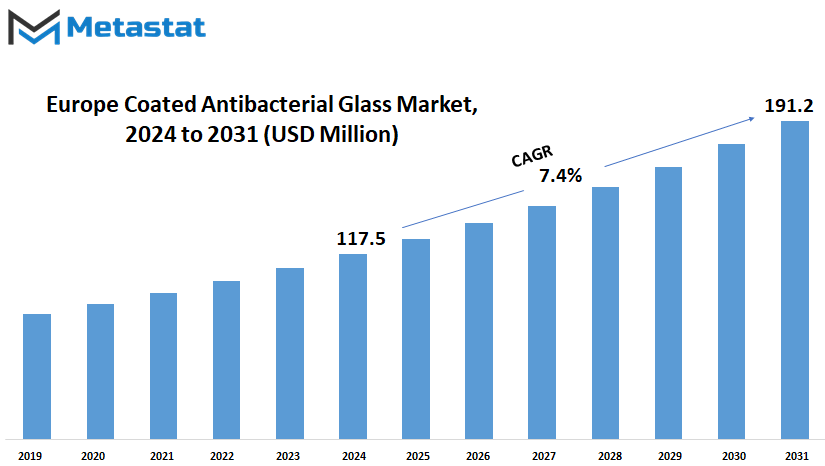
GROWTH FACTORS
The future of the coated antibacterial glass market in Europe looks promising, driven by several key factors. One of the primary drivers is the increasing awareness of infection control and hygiene, particularly in healthcare settings. As hospitals and clinics strive to reduce the spread of infections, the demand for antibacterial glass is expected to rise. This specialized glass, with its ability to kill or inhibit the growth of microorganisms, is becoming an essential component in maintaining sterile environments. This heightened focus on cleanliness and safety in medical facilities will undoubtedly continue to boost the market.
Another significant factor supporting market growth is the rising use of antibacterial materials in consumer products and public infrastructure. From touchscreen devices to kitchen surfaces, the integration of antibacterial coatings is becoming more widespread. This trend reflects a broader consumer interest in products that offer enhanced hygiene, which is likely to drive further adoption of antibacterial glass in various applications. Additionally, public infrastructure projects, such as the construction of schools, offices, and transportation hubs, increasingly incorporate antibacterial materials to improve public health outcomes, further fueling market demand.
However, the market faces challenges that could slow its expansion. High production costs and the complexity of manufacturing processes are significant barriers. Producing coated antibacterial glass requires specialized technology and materials, which can be expensive and difficult to manage. These factors can limit the widespread adoption of antibacterial glass, particularly in cost-sensitive markets. Furthermore, consumer awareness and skepticism about the effectiveness of antibacterial coatings may hinder market growth. Many potential users are not fully informed about the benefits of antibacterial glass, and some may doubt its efficacy, which can impact their purchasing decisions.
Despite these challenges, there are opportunities for growth in the coated antibacterial glass market. Developing cost-effective coating technologies could make antibacterial glass more accessible and appealing to a broader range of consumers and industries. Innovations that simplify the production process and reduce costs will be crucial in overcoming current barriers. Additionally, expanding applications in new markets, such as hospitality and transportation, present lucrative opportunities. Hotels, restaurants, and transit systems are increasingly recognizing the value of antibacterial surfaces in enhancing customer safety and satisfaction, which could drive significant market expansion in these sectors.
While the European coated antibacterial glass market faces some obstacles, the overall outlook remains positive. The increasing emphasis on hygiene and infection control, coupled with the growing use of antibacterial materials in everyday products and public spaces, will continue to drive demand. Addressing production costs and consumer awareness issues, alongside tapping into new markets, will be key to sustaining and accelerating market growth in the coming years.
MARKET SEGMENTATION
By Type
The European market for coated antibacterial glass is poised for significant growth in the coming years. This market is divided into different types of coatings, namely silver, copper, and others. Each type of coating offers unique benefits and potential applications, contributing to the overall development and adoption of antibacterial glass across various sectors.
Silver-coated antibacterial glass is widely recognized for its effectiveness in killing a broad spectrum of bacteria. Silver ions disrupt bacterial cell membranes, leading to the death of the microorganisms. This type of glass is especially popular in healthcare settings, where maintaining a sterile environment is crucial. Hospitals, clinics, and laboratories are increasingly using silver-coated glass to minimize the risk of infections, providing a safer environment for both patients and healthcare workers.
Copper-coated antibacterial glass is another promising segment in this market. Copper has natural antimicrobial properties, and its use in glass coatings can significantly reduce the presence of harmful bacteria. Copper-coated glass is particularly useful in environments where frequent human contact occurs, such as public transportation, schools, and office buildings. The integration of this glass can enhance hygiene and contribute to public health, reducing the spread of infections in densely populated areas.
Beyond silver and copper, other types of antibacterial coatings are being developed and implemented. These include a variety of metal oxides and organic compounds, each offering distinct advantages in specific applications. As research in nanotechnology and material science progresses, the effectiveness and versatility of these coatings are expected to improve, leading to broader adoption across different industries.
Looking towards the future, the demand for coated antibacterial glass in Europe is likely to expand beyond traditional healthcare and public spaces. The food and beverage industry, for instance, can benefit from using antibacterial glass in food processing and packaging to ensure product safety and extend shelf life. Similarly, the use of such glass in residential buildings can promote healthier living environments, particularly in kitchens and bathrooms where bacteria tend to thrive.
Innovation in this market will be driven by the ongoing need to address public health concerns and the desire for cleaner, safer environments. As technology advances, we can anticipate the development of more efficient and cost-effective antibacterial coatings. Additionally, increased awareness of hygiene and infection prevention, accelerated by recent global health crises, will further fuel the adoption of antibacterial glass.
By Glass Type
The European Coated Antibacterial Glass market is segmented by Glass Type into Soluble, Porous, Coated, and Others. This segmentation allows for a more detailed understanding of the market dynamics and the specific characteristics of each glass type.
Soluble glass, as the name suggests, dissolves in a liquid medium. It's particularly useful in applications where temporary protection or antibacterial properties are needed, such as in medical settings or food packaging.
Porous glass contains tiny pores or voids within its structure, which can be advantageous for applications requiring controlled release of antibacterial agents. This type of glass offers a high surface area, allowing for efficient interaction with bacteria or other contaminants.
Coated glass is perhaps the most versatile type, as it can be customized with various antibacterial coatings to suit specific needs. These coatings can range from silver-based compounds to more advanced nanomaterials, offering different levels of effectiveness and durability.
The Others category encompasses glass types that may not fit neatly into the previous three classifications. This could include hybrid glass compositions or emerging materials that are still in development. The inclusion of this category ensures that the market analysis remains comprehensive and adaptable to future innovations.
Each glass type brings its own set of advantages and limitations to the table. Soluble glass, for instance, may offer temporary antibacterial properties but could be less durable in the long term compared to coated or porous alternatives. Porous glass, on the other hand, may provide sustained release of antibacterial agents but could be more challenging to manufacture at scale.
The European market for coated antibacterial glass is poised for growth as advancements in materials science and manufacturing techniques continue to drive innovation. With increasing concerns about hygiene and infection control, demand for antibacterial surfaces is expected to rise across various industries, including healthcare, hospitality, and transportation.
In addition to traditional applications like countertops and medical equipment, coated antibacterial glass could find new uses in emerging sectors such as smart homes and wearable technology. Imagine, for instance, a self-cleaning glass surface that actively repels bacteria, or antimicrobial coatings embedded in everyday objects like smartphone screens or kitchen appliances.
By Application
In the ever-advancing world of technology and innovation, one area that continues to see significant progress is the development of antibacterial coatings for glass surfaces. One such market, the Europe Coated Antibacterial Glass market, is witnessing notable growth and diversification. This market, segmented by application, encompasses a wide range of sectors, each benefiting from the antibacterial properties of coated glass.
Among the various applications of coated antibacterial glass in Europe, one prominent sector is Hospital Wards. With the increasing emphasis on maintaining sterile environments in healthcare facilities, the use of antibacterial glass coatings in hospital settings will become increasingly prevalent. These coatings will help in reducing the spread of harmful bacteria and contribute to overall hygiene standards, thus enhancing patient safety and well-being.
Another significant application of coated antibacterial glass is in Food and Beverage Products. In industries where hygiene is of paramount importance, such as food processing and beverage manufacturing, the use of antibacterial glass coatings can help prevent contamination and ensure product quality. From food packaging to processing equipment, the incorporation of antibacterial properties will play a crucial role in safeguarding consumer health.
Furthermore, the utilization of coated antibacterial glass extends to Military Equipments. In military applications, maintaining cleanliness and preventing the proliferation of bacteria is essential, especially in confined spaces such as military vehicles and equipment. Coated antibacterial glass can aid in reducing the risk of infections among military personnel and enhance operational efficiency in challenging environments.
Moreover, the Household Products sector stands to benefit significantly from the adoption of coated antibacterial glass. In homes, the use of antibacterial coatings on glass surfaces, such as kitchen countertops and bathroom fixtures, can help in maintaining a clean and hygienic living environment. This will be particularly advantageous in households with young children or elderly individuals, where the risk of bacterial infections may be higher.
Additionally, the application of coated antibacterial glass extends to various other sectors, collectively referred to as "Others." This includes but is not limited to public transportation, educational institutions, and commercial buildings. As awareness regarding hygiene and sanitation continues to grow, the demand for antibacterial glass coatings across diverse applications will only increase.
The Europe Coated Antibacterial Glass market, segmented by application, offers a glimpse into the future of hygiene and cleanliness across various sectors. From healthcare facilities to households and beyond, the incorporation of antibacterial properties into glass surfaces will play a pivotal role in ensuring a safer and healthier environment for all.
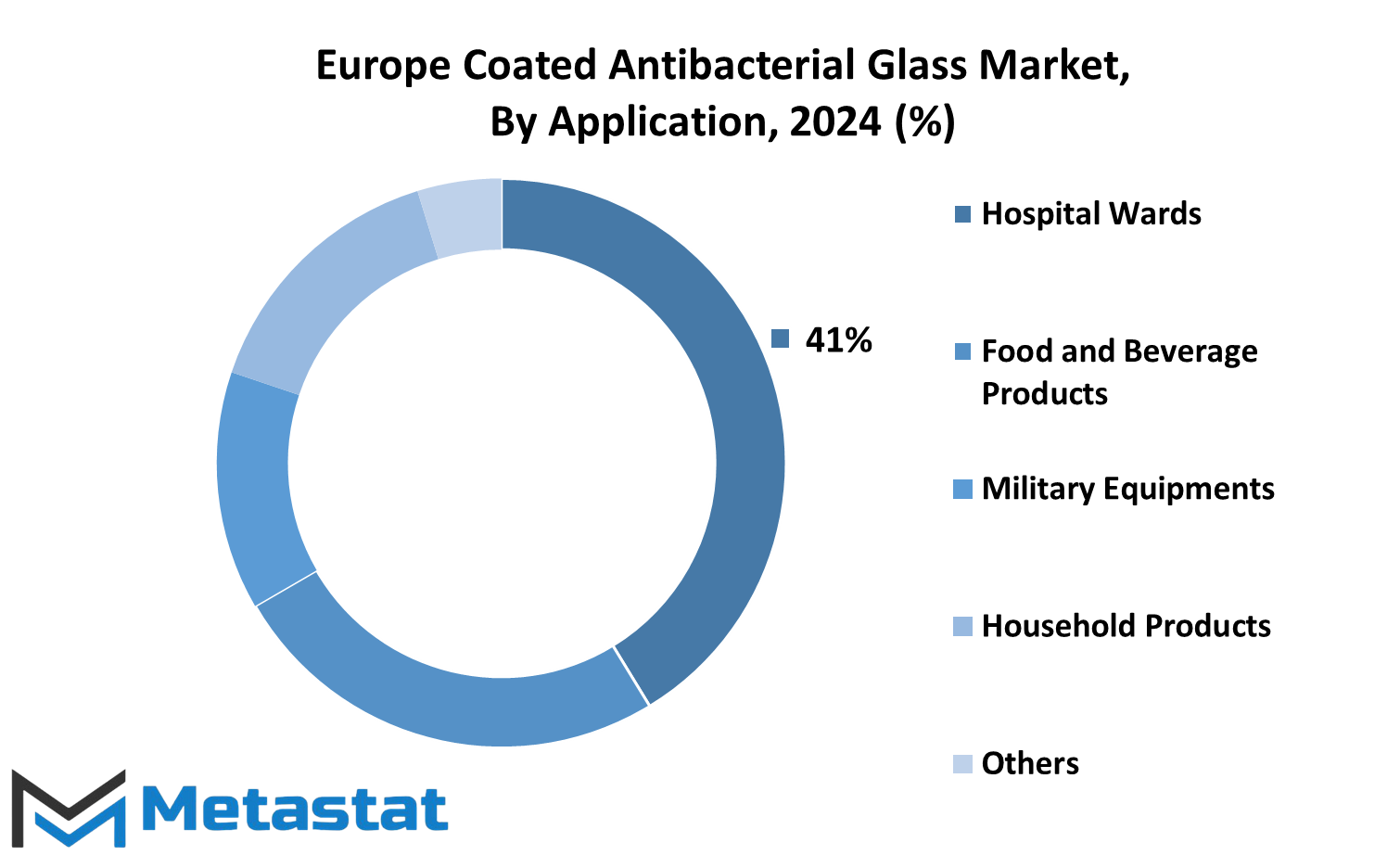
REGIONAL ANALYSIS
The future of the European coated antibacterial glass market looks promising, with significant growth expected in the coming years. This market includes major countries such as the UK, Germany, France, Italy, and the rest of Europe. The increasing demand for hygiene and safety in various settings is a key driver for this market. Hospitals, schools, public transportation, and even residential spaces are increasingly seeking solutions that prevent the spread of bacteria and viruses. As awareness of health and safety continues to rise, the need for antibacterial glass is set to expand.
Technological advancements play a crucial role in the development of more effective antibacterial coatings. These innovations aim to provide better protection and longer-lasting effects, making the glass more efficient and desirable. With continuous research and development, we can anticipate more sophisticated products that will offer enhanced protection against a broader range of pathogens.
The healthcare sector in Europe is a major contributor to the demand for coated antibacterial glass. Hospitals and clinics require stringent hygiene standards, and antibacterial glass can help reduce the risk of infections. The adoption of this technology in medical facilities is likely to increase, driven by the necessity to maintain sterile environments. Furthermore, the ongoing challenges posed by antibiotic-resistant bacteria underscore the importance of non-antibiotic solutions like antibacterial glass.
Educational institutions are another area where the demand for antibacterial glass is growing. Schools and universities, where large numbers of people gather, can benefit from such products to maintain cleaner environments. The integration of antibacterial glass in public buildings and transportation systems is also expected to rise, providing safer spaces for daily commuting and public interactions.
In residential areas, the use of antibacterial glass is becoming more common. Homeowners are increasingly aware of the benefits of having surfaces that can help prevent the spread of germs. Kitchens, bathrooms, and other high-touch areas can particularly benefit from these innovative products. As people continue to prioritize health and cleanliness in their homes, the demand for antibacterial glass in the residential market will likely see a substantial increase.
The coated antibacterial glass market in Europe is poised for substantial growth, driven by the rising awareness of health and hygiene, advancements in technology, and the diverse applications across various sectors. As these trends continue to evolve, the market is expected to expand, providing innovative solutions that contribute to a safer and healthier environment for everyone. The future of this market holds great potential, promising to meet the ever-increasing demands for better hygiene standards in our everyday lives.
COMPETITIVE PLAYERS
The European market for coated antibacterial glass is poised for significant growth, driven by a variety of competitive players who are innovating and expanding their offerings. This market is characterized by companies that have established themselves as leaders in the production and development of advanced glass technologies. Notable among these are Nippon Electric Glass Co., Ltd., AGC Glass Europe, SmartGlass International Ltd. (SGI), Newline Interactive, Corning, Kastus Technologies Ltd., Ishizuka Glass Co., Ltd., Pilkington (NSG Group), SCHOTT AG, Glas Trösch Holding AG, NanoTech Coatings, and Sisecam Group.
These companies are continually pushing the boundaries of what coated antibacterial glass can achieve. They are investing in research and development to create products that meet the increasingly stringent hygiene and safety standards demanded by various industries. For instance, hospitals and healthcare facilities are major consumers of antibacterial glass, which helps in reducing the spread of infections. This growing demand is prompting key players to enhance the antimicrobial efficacy of their products while ensuring durability and clarity.
Nippon Electric Glass Co., Ltd. and AGC Glass Europe, for example, are well-known for their commitment to innovation. They are developing new coatings that not only kill bacteria but also offer additional benefits like scratch resistance and easy cleaning. These advancements are crucial as they provide end-users with long-lasting and effective solutions. Similarly, companies like SmartGlass International Ltd. (SGI) and Newline Interactive are integrating smart technology with antibacterial properties, thus providing multifunctional glass solutions that can be used in a variety of settings, from corporate offices to educational institutions.
Corning and Kastus Technologies Ltd. are also at the forefront, known for their patented technologies that ensure high performance. Corning's expertise in glass science and Kastus's proprietary coating techniques are setting new benchmarks in the industry. Their collaboration with tech companies and continuous investment in state-of-the-art manufacturing facilities underscore their leadership in this sector.
Moreover, companies like Pilkington (NSG Group) and SCHOTT AG bring decades of experience to the table, which allows them to refine their products continually. They are focusing on creating glass that not only meets current health standards but anticipates future regulatory changes. The same goes for NanoTech Coatings and Sisecam Group, which are leveraging nanotechnology to enhance the antibacterial properties of their glass products.
The European coated antibacterial glass market is vibrant and dynamic, driven by competitive players who are committed to innovation and quality. As these companies continue to develop and refine their products, we can expect to see more advanced and versatile glass solutions that will play a critical role in enhancing public health and safety across various sectors. This forward-looking approach ensures that the market will remain robust, adapting to new challenges and opportunities with agility and expertise.
Coated Antibacterial Glass Market Key Segments:
By Type
- Silver
- Copper
- Others
By Glass Type
- Soluble
- Porous
- Coated
- Others
By Application
- Hospital Wards
- Food and Beverage Products
- Military Equipments
- Household Products
- Others
Key Europe Coated Antibacterial Glass Industry Players
- Nippon Electric Glass Co., Ltd.
- AGC Glass Europe
- SmartGlass International Ltd. (SGI)
- Newline Interactive
- Corning
- Kastus Technologies Ltd.
- Ishizuka Glass Co., Ltd.
- Pilkington (NSG Group)
- SCHOTT AG
- Glas Trosch Holding AG
- NanoTech Coatings
- Sisecam Group
WHAT REPORT PROVIDES
- Full in-depth analysis of the parent Industry
- Important changes in market and its dynamics
- Segmentation details of the market
- Former, on-going, and projected market analysis in terms of volume and value
- Assessment of niche industry developments
- Market share analysis
- Key strategies of major players
- Emerging segments and regional growth potential



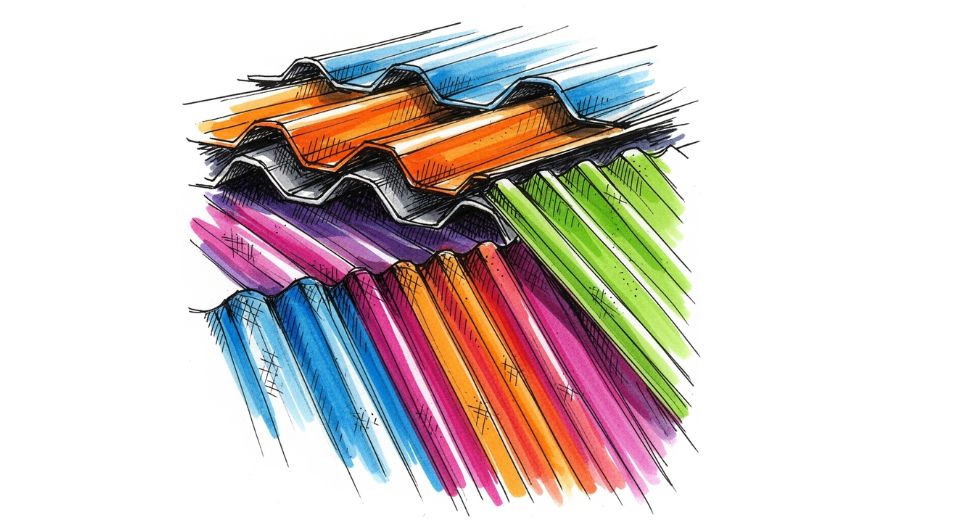
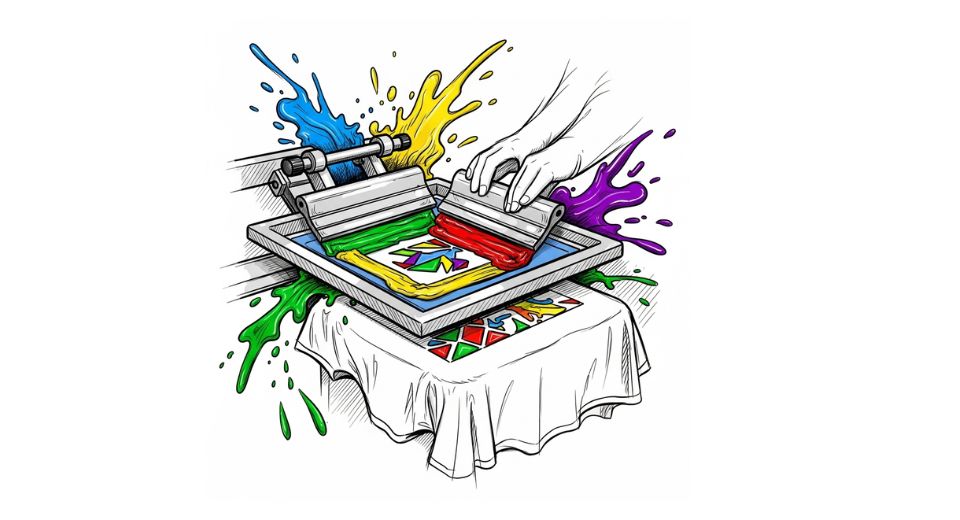
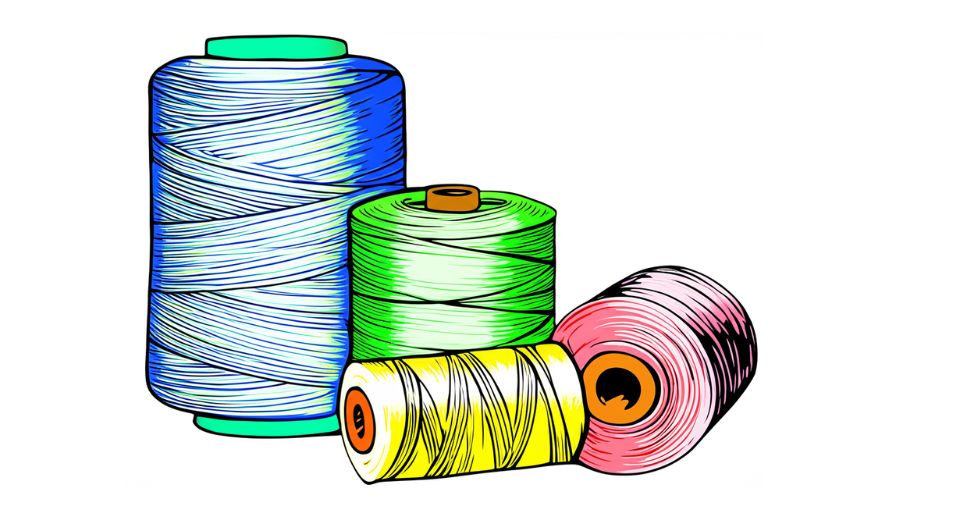
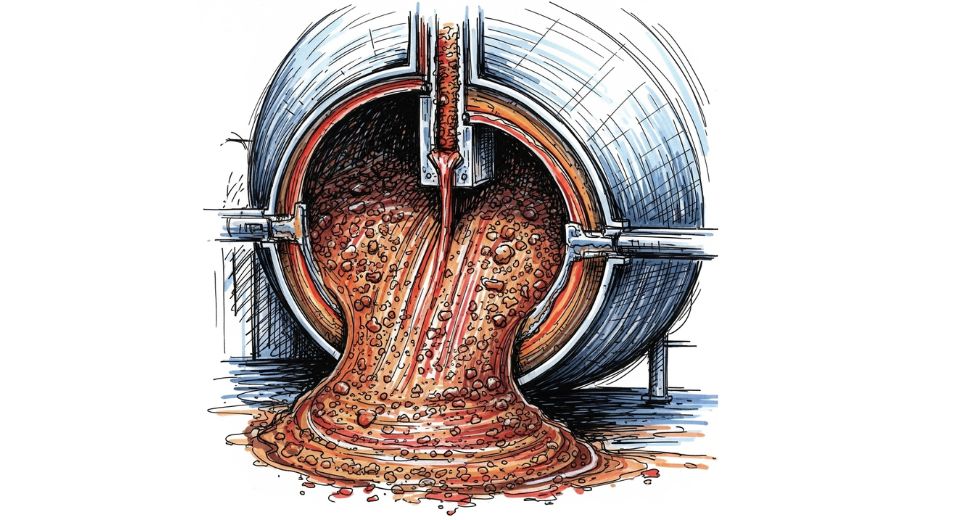

 US: +1 3023308252
US: +1 3023308252






